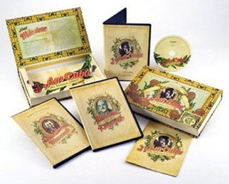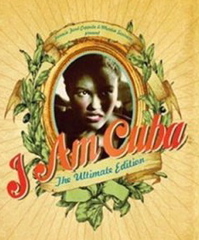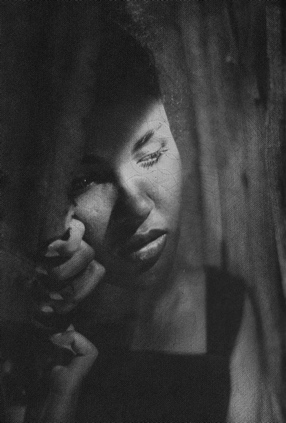| Release List | Reviews | Price Search | Shop | Newsletter | Forum | DVD Giveaways | Blu-Ray/ HD DVD | Advertise |
| Reviews & Columns |
|
Reviews DVD TV on DVD Blu-ray International DVDs Theatrical Reviews by Studio Video Games Features Collector Series DVDs Easter Egg Database Interviews DVD Talk TV DVD Talk Radio Feature Articles Columns Anime Talk DVD Savant HD Talk Horror DVDs Silent DVD
|
DVD Talk Forum |
|
|
| Resources |
|
DVD Price Search Customer Service #'s RCE Info Links |
|
Columns
|
 |
I Am Cuba |

|
I Am Cuba Milestone / New Yorker 1964 / B&W / 1:33 flat full frame / 141 min. / Soy Cuba / Street Date November 20, 2007 / 44.95 Starring José Gallardo, Raúl Garcia, Luz María Collazo, Mario González Broche, Raquel Revuelta Cinematography Sergei Urusevsky Production Design Yevgeni Svidetelev Film Editor Nina Glagoleva Original Music Carlos Fariñas Written by Enrique Pineda Barnet, Yevgeni Yevtushenko Produced by ICAIC, Goskino Directed by Mikhail Kalatazov |
Milestone Film and Video celebrates its growing prominence as an independent distributor with this lavish I Am Cuba: The Ultimate Edition disc set. Mikhail Kalatazov's 'lost' revolutionary epic is presented in an extravagant package decorated like a box of Cuban cigars, and with extras that include two full-length documentaries.
The film is an ode to the spirit of Castro's Revolution, told in four poetic movements that extol Cuban resistance to the corrupt Battista regime. Sergei Urusevsky's camera ducks and weaves to follow Kalatazov's frenzied direction, performing feats of near magic as it glides up and down the sides of buildings and into a swimming pool. The most impressive shot floats out a balcony to hover over the funeral procession of a revolutionary martyr. The director and cameraman build an entire film out of the impressive unbroken tracking shots from their previous international success The Cranes are Flying. Many elaborate handheld scenes last minutes without a cut, as the ultra wide-angle lens tracks action like a snake. Urusevsky uses infrared film stock to increase contrast and lend foliage an unnatural glowing white; we're told that the film may have been the first to use a video assist to allow Kalatazov to instantly review his takes.
The movie was planned as a grand statement of Soviet solidarity with Cuba's infant revolution. Young Russian intellectuals were excited about the vitality of the island nation's politics, and despite the involvement of top Cuban writers the film is ultimately more concerned with political cinematics than the reality of Cuban life. The non-pro actors provide the expressive faces but the ideologically minded script and the camera acrobatics do the heavy lifting. Kalatazov was clearly trying to out-do Eisenstein's Battleship Potemkin, replacing the master's montage aesthetics with audacious new camera techniques. The steps of the Havana University had also been a center of rebellion against Gerardo Machado in 1933 1, and Kalatazov uses them to stage a dramatic, if simplistic student/police confrontation highly reminiscent of Potemkin's Odessa Steps.
A soothing female narrator (Raquel Revuelta) provides a voice for the country itself. Set before the revolution,I Am Cuba's four episodes are interwoven with little poetic movements, such as a shot on a canoe moving past marshland huts where children play and mothers work. A bathing suit contest takes place on a high balcony, and the camera descends to observe the rich cavorting by a pool, itself several stories in the air. The cabaret song "Loco Amor" introduces a nightclub where fancy prostitutes are offered to rich American tourists. 'Good' Cuban girl Mariía (Luz María Collazo) hides the fact that she's "working for the Yankee dollar" from her naïve boyfriend, and reports for duty at the nightclub. She tries to forget her shame in a wild dance, after which her curious client accompanies her to her home in a shanty town.
Told that the land he farms has been sold to the United Fruit Company, old Pedro (José Gallardo) realizes he'll no longer be able to make a living. He sends his kids to town to drink Coca-Cola and lights a torch.
University student Enrique (Raúl Garcia) cannot make himself assassinate the corrupt police chief. He then throws himself into harm's way by leading a student demonstration and confronting the armed cops on the University steps.
A peasant in the hills thinks he can avoid the fighting, but when the government bombs his home and kills one of his children, he takes up a gun and joins la revolucíon.

Breathtaking visuals aside, much of I Am Cuba is still unsubtle propaganda. The evil Yankee whoremongers (played by obvious Russians) think they can buy everything. Even the relatively thoughtful intellectual takes María's crucifix as a souvenir. Traditional guitar music is by definition beautiful and American Rock 'n' Roll is depraved. Rural peasants are noble innocents, and Havana's revolutionary youth are impassioned martyrs. The farmer with a family must suffer before learning the ecstasy of armed revolution, a sequence that Kalatazov illustrates with fluid imagery Eisenstein only dreamed of. The film borrows from Italian Neorealism when María's curious client is panicked by the awful hunger and poverty of her slum neighborhood. 2 (Spoiler) The Russians envision the Cuban characters as symbols, as when a fallen comrade appears to rise from the dead to participate in the glory of victory. The idea that the peasant must desert his family conjures fanatic images from the Mexican Revolution, with Pancho Villa massacring his soldiers' dependents so they'll be free to fight. Cuban viewers might resent being objectified in this way, especially by foreigners; the simplistic 'noble peasant' role isn't all that different from the American 'happy peasant' stereotype.
We're told that the expensive production had disappointing premieres in Havana and Moscow, after which it was suppressed and forgotten. Kalatazov's 'technique over content' philosophy didn't fit in with Russia's preference for socialist realism. Cubans may have thought that the film exploited their experience to illustrate an abstract (and very Russian) ideological fantasy. With the Missile Crisis now 45 years past and the Soviet Union dissolved, the film can now be appreciated with more objectivity. For Americans curious about the Cuban experience in that era, the film's many views of Havana are priceless. When the student revolutionaries stop on a street corner, we see the yanqui movie Esto es Cinerama announced on the marquee of a giant Cinerama theater!
American film enthusiasts flipped when Milestone brought I Am Cuba back from total obscurity. Inspired by the title scene in Touch of Evil or the films of Max Ophuls, young directors of the 1990s often favored ostentatious one-shot masters to distinguish themselves. When Kalatazov proved to be the undisputed master of the choreographed hand-held camera, I Am Cuba proved an art house hit. The twisting, gravity-defying point of view tends to bowl over first-time viewers, leaving memories of a few expressive faces and a LOT of swirling visuals. A second pass allows us to appreciate the economy of Kalatazov's storytelling. His characters are animated by sheer visual power. Accept them as iconic players in the collective revolution, and the film works.

Milestone released a stand-alone I Am Cuba disc in 2000 that Savant hasn't seen. Their deluxe I Am Cuba: The Ultimate Edition sports an excellent flat B&W encoding. The packaging says this is a new transfer from Russian vault elements. Audio is in Spanish and a little English; subtitles offer up the text of the Russian dialogue version or the Spanish version -- they apparently diverge with some character names changing. The first disc has a still gallery, a trailer and a video essay on Cuba, along with a lengthy interview with Martin Scorsese. He and Francis Coppola loaned their names to the film's theatrical premiere; Scorsese says that his entire career might have been different had he seen I Am Cuba when it was new.
Disc two offers a fascinating 90-minute Brazilian making-of docu called The Siberian Mammoth. Leavened with many key interviews, the docu reminds us that the film was made in the hottest years of the Cold War. Russians and Cuban participants reflect on what the film meant to them, resulting in an interesting dialogue about cinema, politics and national identity. Russian poet and I Am Cuba screenwriter Yevgeny Yevtushenko appears on a New York educational station to talk about the film; he starts off by remembering how exciting the young Cuban revolutionaries seemed, in contrast to the boring politicians back in the USSR.
Disc Three contains a two-hour docu on director Mikhail Kalatazov, featuring lengthy input from Claude Lelouch and many film clips. As with many another Soviet director, Kalatazov's career veered between 'accepted' status and long periods when he'd be forbidden to work because of perceived ideological flaws in his work. Finishing off the disc set is an insert booklet containing Milestone founders Dennis Doros and Amy Heller's annotated account of the film's eventual rediscovery.
On a scale of Excellent, Good, Fair, and Poor,
I Am Cuba: The Ultimate Edition rates:
Movie: Excellent
Video: Excellent
Sound: Excellent
Supplements: Two additional feature-length documentaries, trailer, stills, interview with Martin Scorsese, Interview with Yevgeny Yevtushekno.
Packaging: Three slim cases and booklet in 'cigar box' novelty packaging
Reviewed: November 17, 2007
Footnotes:
1. John Huston's We Were Strangers recreates an incident on these steps in 1933, when the dictator Machado's police fired on students without warning.
Return
2. The sequence pretty much repeats a chapter from Rossellini's Paisan (1946). A black U.S. soldier chases after an Italian kid who has stolen his boots, following him into a sewer. There he discovers an entire homeless community living in horrendous squalor.
Return
Reviews on the Savant main site have additional credits information and are more likely to be updated and annotated with reader input and graphics.
Review Staff | About DVD Talk | Newsletter Subscribe | Join DVD Talk Forum
Copyright © MH Sub I, LLC dba Internet Brands. | Privacy Policy | Terms of Use
|
| Release List | Reviews | Price Search | Shop | SUBSCRIBE | Forum | DVD Giveaways | Blu-Ray/ HD DVD | Advertise |





